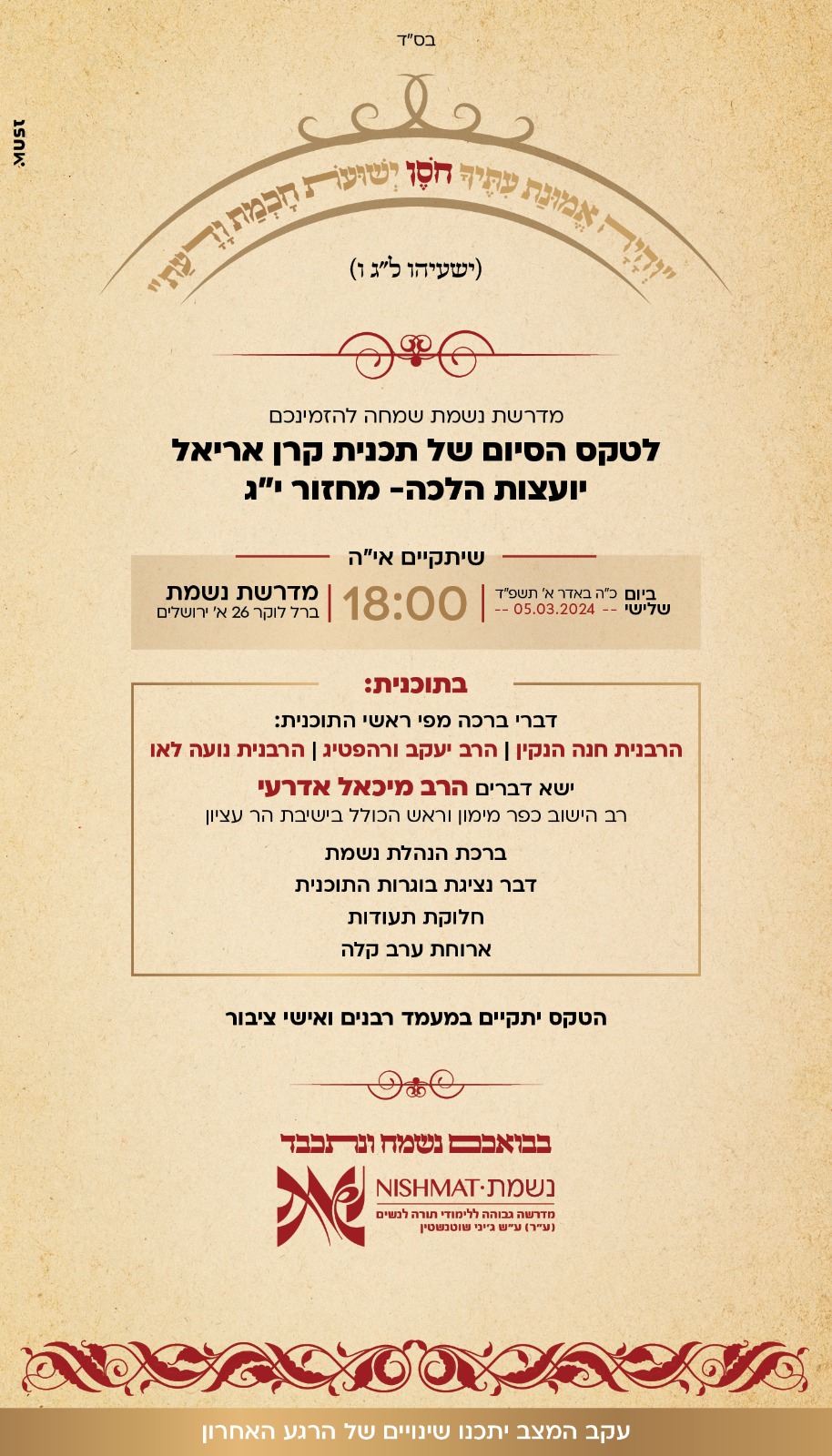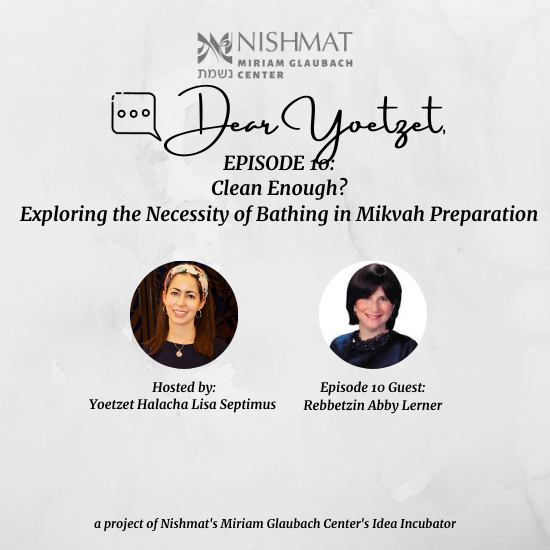Ideally, a kallah (bride) becomes tehorah shortly before her wedding by observing the seven clean days and then immersing in a mikveh. However, when it is not possible to complete this process before the wedding, the wedding still takes place on time, and the kallah will immerse afterwards, as soon as it’s halachically permissible. If this is the case, there will be some changes in the wedding plans, but these changes need not be obvious to anyone, nor do they affect the joyfulness of the wedding celebration.
Why does a Kallah need to immerse?
A kallah is considered niddah before her wedding even if she has not bled for some time, for two reasons:
1. A woman is in niddah from the time of her first menstruation until she completes the process of becoming tehorah by immersing in a mikveh. This is the case even if her last period passed long before the wedding.
2. There is a halachic concern that a kallah’s excited anticipation of the upcoming wedding and marital relations might have a physical effect and lead to uterine bleeding. This bleeding, known halachically as dam chimud (lit., “blood of yearning”), may be so slight that it goes unnoticed, and therefore a kallah is always considered niddah until she counts seven clean days and immerses shortly before her wedding.
Even a previously married woman who has experienced no bleeding since her last mikveh immersion needs to undertake the process of becoming tehorah prior to her remarriage, out of concern for dam chimud.
How does this process work for a kallah?
A kallah’s process of becoming tehorah is similar to that of a married woman, with a few modifications.
Bedikot
Before her wedding, a kallah needs to perform a hefsek taharah (the initial internal examination that establishes that bleeding has stopped) and observe the shivah neki’im (seven clean days), including bedikot (internal examinations).
It is possible for a kallah to perform a hefsek taharah and bedikot even if her hymen is intact. The hymen is a membrane just inside the entrance of the vagina. The opening of the hymen, which allows for the exit of menstrual blood, is generally large and stretchy enough to accommodate a narrow tampon or a bedikah.
For some kallot, often those who have had positive experiences using tampons, performing bedikot is simple and straightforward. For others, there may be some initial discomfort, and it can take time to find a comfortable way to perform a bedikah.
It is important to know that the vaginal canal is made from muscles that can be contracted and relaxed. A woman can consciously tighten and relax these muscles. To insert a tampon or perform a bedikah, a woman has to relax the vaginal muscles so as to open up the vaginal canal.
It is also helpful to understand the internal reproductive and sexual anatomy so as to know the direction of insertion for a bedikah. The vaginal canal leans both up and toward the back. Inserting anything either only upwards or only backwards will not be effective and will press on other internal organs.
Learning about her body and physiology can also help the kallah feel more prepared for sexual intimacy after the wedding.
Some modifications can make bedikot easier and more comfortable for a kallah who is having difficulty performing them. For example, before her wedding a kallah need not insert her finger beyond the first knuckle if deeper bedikot are uncomfortable. She should take care to rotate the bedikah cloth very gently within the vagina, lightly touching internal folds and crevices. She may also omit the moch dachuk until she is comfortable performing full bedikot after the wedding.
It is important to be candid with one’s kallah teacher about how the bedikot feel, and not to force them if there is difficulty. In some cases, the number of bedikot required can be reduced. If there is pronounced discomfort or distress performing a bedikah, it is advisable to consult a physician (preferably a gynecologist) or pelvic floor physical therapist.
Tips for First Bedikot
- Practice doing bedikot a cycle or two prior to the wedding, so that the first attempts are unhurried and relaxed.
- Set reminders with your kallah teacher for the planned date of the hefsek taharah and bedikot. Make special note not to forget the hefsek taharah and the bedikot on days one and seven of the shivah neki’im. Note that bedikot are performed during the day, between sunrise and sunset.
- Set aside a time and place that will enable you to go slowly and learn how do bedikot gently and comfortably.
- Use the softest bedikah cloths available, generally those made from cotton knit (t-shirt material). If necessary, you can try pre-washing your bedikah cloths to soften them, or making your own cloths out of soft white undershirts or the like.
- Before performing the first bedikot, we recommend taking a moment to look at your anatomy in the mirror and identify the vaginal opening, where the cloth is inserted. Take your time guiding the cloth to the right place.
- Find a position that’s comfortable for you. Putting one leg up on a stool, or crouching down, and using one hand to open the labia (lips of the vagina) and the other to insert the cloth, can help increase the comfort of bedikot. Some women may feel more relaxed lying down on a bed to do the bedikah.
- If you are feeling anxious and your vaginal muscles are tightening up, you can try techniques that increase relaxation (e.g., deep breathing, listening to music, thinking calming thoughts) to help make bedikot easier.
- If the vaginal area seems dry, you can dampen the bedikah cloth slightly with water. If this is not sufficient, you can check in with your kallah teacher or health care provider about other possibilities. For example, it’s halachically permissible to apply a small amount of water-based vaginal lubricant (available in most pharmacies) to the vaginal area. You should wait about 15 minutes between applying the lubricant and performing the bedikah.
Staining
Sometimes, a kallah may experience staining or find bloody discharge during her shivah neki’im. This will not necessarily delay her immersion.
If a kallah finds a questionable color discharge on a bedikah cloth, she should ask a halachic question as soon as possible and refrain from further bedikot until she is advised how to proceed. Similarly, if she finds any staining on her clothing or anywhere else, she should seek halachic guidance and wait with her bedikot. She may be advised to reduce the number of bedikot and to take extra precautions so as to be able to continue with her clean days.
A kallah teacher can often help a kallah ask her questions. Yoatzot Halacha are available for questions from kallot and can also make referrals to local halachic authorities. Yoatzot are located in Israel and in many locations around the world, and are accessible through this site and a telephone hotline.
When asking a question, a kallah should be sure to mention when she is getting married. There is often extra room for leniency before a wedding. Additionally, although the hymen is flexible enough that shallow and gentle bedikot are very unlikely to cause tearing, hymenal irritation does occasionally result from bedikot. Such bleeding is considered dam makkah (bleeding from an injury) and would not make a woman niddah, nor would it affect the halacha of dam betulim. If this is suspected, one should seek halachic guidance.
Timing
Because of the concern about dam chimud, a kallah should plan on mikveh immersion close to the wedding. This can have implications for choices about scheduling the wedding and cycle manipulation leading up to it.
The Hefsek Taharah
Before her wedding, a kallah may perform her hefsek taharah as soon as bleeding stops, or she may delay it, depending on her planned mikveh timing.
A kallah generally performs a hefsek taharah seven days before her planned mikveh immersion. However, it is advisable to perform a bedikah a day or two earlier, eight or nine days before mikveh, to serve as a back-up hefsek taharah just in case she forgets or is unable to do the hefsek taharah on the day she had planned. For example, a kallah planning immersion for a Tuesday night should perform a hefsek taharah by Tuesday afternoon before sunset a week earlier; she would be well advised to attempt a back-up bedikah before that, on Sunday or Monday.
If she ends up relying on the back-up, she would still be able begin her shivah neki’im on the day she had planned, and would conclude her count the day of her immersion.
After her immersion, she should change to colored undergarments and take precautions to avoid becoming niddah due to stains.
Timing of Mikveh Immersion
There is some preference for a kallah to go to mikveh the night before the wedding. When this is not possible or convenient, she should still try to immerse as close as possible to the wedding date, up to four days before the wedding. For example, for a Sunday night wedding, the earliest she may immerse is Wednesday night.
Halachic authorities debate whether a kallah who immerses earlier than the night before her wedding needs to perform a bedikah on each intervening day to check for dam chimud. We follow the position that a kallah immersing within four days of the wedding does not usually need to perform extra bedikot between immersion and the wedding.
If a kallah needs to immerse more than four days before her wedding, (e.g., the wedding will be in a city far from a mikveh), then it is permissible to immerse earlier. However, she should ask a halachic authority how to proceed with her bedikot after the immersion.
A kallah should usually plan to complete her clean days on the day of her immersion, no more than four days before the wedding. We follow the view that if a kallah completes her clean days more than six days before the wedding, she should perform an extra bedikah in between, due to concerns of dam chimud.
In some communities, the custom is for a kallah to immerse in the daytime, the day after she has completed her shivah neki’im (e.g., during the day Wednesday, a week after a Tuesday hefsek taharah). While a married woman immerses only at night, it is permissible for a kallah to immerse in the daytime.
First Immersion
It is customary for a kallah to make an appointment in advance for her mikveh immersion, letting the mikveh know that she is a kallah. Many mikva’ot have special rooms for kallot and will provide extra attention and services to a new bride. Some kallot seek out an especially nice, spa-like mikveh for their first immersion, while others prefer to make an appointment at a mikveh near their home or at the mikveh that they will use in the beginning of married life. By scheduling her immersion well in advance, the kallah has the opportunity to consider how immersion and the preparation for it will fit in logistically with other wedding preparations.
In some communities, a kallah is accompanied to the mikveh by her mother or a close friend; this can be an intimate moment, woman to woman, at which familial mikveh traditions are passed down. Some communities celebrate the pre-wedding immersion with a larger group of female friends and relatives, as at a chinna (the henna is not considered a barrier to immersion). Usually only the mikveh attendant observes the actual immersion, but a kallah can arrange in advance to have another woman of her choice be there instead.
At the first immersion, aside from the beracha, a kallah can recite or have in mind a personal prayer. Some kallot compose their own prayer, while others choose from prayers that were written specifically for a kallah at the time of her first immersion.
Nails
Before the wedding, many kallot choose to have a professional manicure and pedicure, including professionally applied nail polish. However, since nail polish can potentially be a chatzitzah, a barrier to immersion, a kallah should ideally immerse without nail polish. It is preferable for a kallah to immerse two, three, or even four days before the wedding, rather than the day before, if this enables her to immerse without nail polish and then have her nails done afterwards.
If this too is difficult to arrange, then she may immerse with her nail polish, so long as there are no chips or cracks, and so long as she cleans well around and underneath the nails. Note that not all mikva’ot will permit immersion with nail polish, and the kallah should check this out in advance.
There is also a custom to immerse with short nails, short enough that they are not visible when looking at one’s palm. A kallah for whom it is important to have longer nails for her wedding need not cut them short, but she needs to take care that they are clean and filed smooth before her immersion in the mikveh.
Some kallot arrange to have their nails professionally trimmed and filed before immersion, and then return to the salon to have the nail polish applied between immersion and the wedding.
Immersion on the Wedding Day
In general, a woman may immerse no earlier than the night following a full count of shivah neki’im. However, if a kallah is unable to get an acceptable hefsek taharah until exactly a week before the wedding, so that she would need to immerse on her wedding night, she may be able to immerse on her seventh clean day, the day of the wedding.
For example, if she cannot get an acceptable hefsek taharah until Tuesday afternoon, and the wedding is the following Tuesday, she would perform her final bedikah on Tuesday morning (the seventh day of shivah neki’im) and immerse in the mikveh that day, before the wedding. In this situation, the chatan and kallah may not be alone together (yichud) until after dark Tuesday night. In these cases, the details and arrangements need to be discussed with a halachic authority.
This article was updated on 6 July, 2023.













